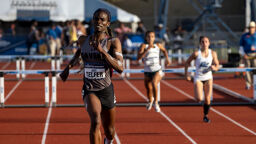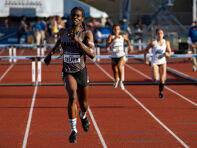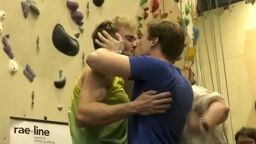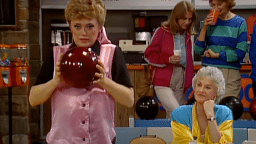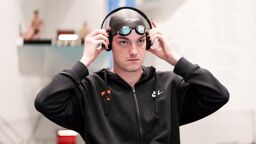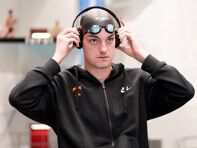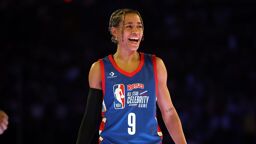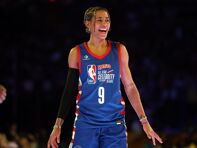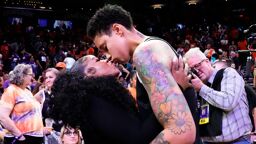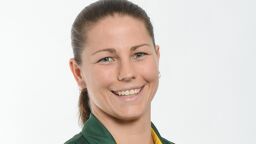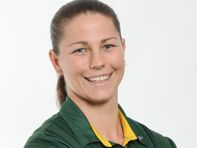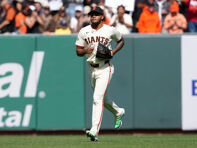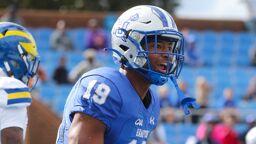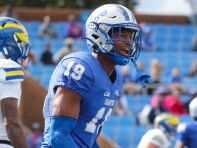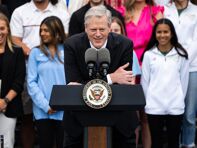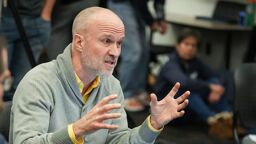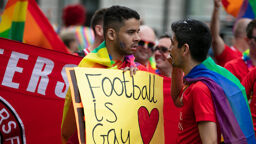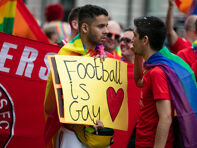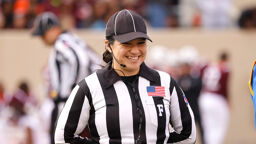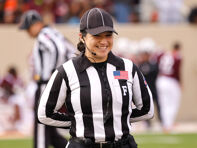Game evolved from 'muscular Christianity' to one embraced by all, including gays and lesbians
By Patricia Nell Warren
Special to Outsports.com
Certain sports seem to be a tougher nut to crack than others – they are more homophobic, more fiercely resistant to change. In the United States, basketball makes the short list of “tough nuts,” along with football and baseball. Among the three, basketball stands out because of its unique history, which gives it a special place in American culture that even football and baseball don’t have. After the first NBA player, John Amaechi, came out in 2007, he was asked by RealJock.com, “You worked for such a long time in this hyper-masculine, heterosexual NBA environment. Where do you feel that this comes from?”
After interviewing Amaechi myself for Frontiers Magazine in mid-2007, I wanted to dig deeper on “where it comes from.” As always, some chilling answers can be found in the pages of history.
 |
| Basketball was invented in the 1890s |
Billed as “the people’s game” and “the most democratic sport,” basketball actually has the most undemocratic roots you can imagine. It was invented in Massachusetts in 1891, by evangelical Protestant church people who were the ancestors of today’s Promise Keepers. In short, basketball has an extra-strong heritage of homophobia.
The sport’s inventor was inspired by “muscular Christianity,” a international 19th-century men’s movement that aimed to make young white males “moral” and “manly” through rugged sports competition. In both England and the U.S., the church establishment had been horrified to notice that same-gender “immorality” was emerging powerfully at all levels of Victorian society. English leaders could glimpse the phenomenon everywhere, from various literary lions to the odd member of the royal family, from institutionalized “fagging” at private schools to the thriving London trade in male prostitution – even the Anglican clergy.
By 1880 scientists were using the clinical term “homosexuality” to describe same-gender attractions. But church leaders never used that word — they preferred to sputter about “unnatural friendships” and “gross indecencies.” In fact, they despised homosexuality, considering it the result of a catastrophic moral lack in a man — an attack on the home life and male patriarchy so sacred to Victorian society (does this sound familiar?). So the muscular movement aimed to force a rebirth of “manliness” at every social level — to protect young men from “immoral influences” and bring them to Jesus by hardening them with competition.
The leaders who pushed hardest for sport as manly godliness were those of the Young Men’s Christian Association (YMCA).
Deadly cities
Founded in England, the YMCA came to the U.S. in 1851 as an outreach to the masses of uprooted young unmarried men piling up in urban centers. The Industrial Revolution was in full rumble, with millions of men migrating to cities, or migrating from other countries, in desperate search of work and a better life. A national network of YMCA bachelor dormitories aimed to offer these men a secure substitute for home life — to keep them from falling into the “evils” of urban life, which included gambling, alcoholism, venereal disease, crime and male prostitution.
But there was a catch. YMCA aimed not only to serve men, but also to convert them. If you stayed there, you had to submit to prosyletizing. In the words of a YMCA history site, Y leaders aimed to “build a Christian superman who would be sober, morally clean, and physically fit to face the perils of the modern age.”
While the English YMCA opted for an ecumenical positioning that made room for many churches, the U.S. branch had that Puritan streak so embedded in American culture. Their definition of “manhood” was pulled from Bible texts, especially those asserting that a man should rule both family and religion. Only young men who belonged to evangelical churches could hold any YMCA office. Catholics, Mormons and Jews were out in the cold. Indeed, the whole U.S. “masculine movement” had a strident bias in favor of white Anglo-Saxon Protestant men, who were viewed as the greatest civilizing force in the world.
Since YMCA was largely an urban movement, green fields were seldom available for outdoor games like football and baseball. So YMCA residential facilities featured locker rooms, gyms and pools where men could do body-building, swimming, calisthenics, gymnastics and other indoor sports in this “protected” environment. Men swam in the nude. Nobody seems to have bothered their heads about where this practice could lead.
From the YMCA, muscular Christianity spread to U.S. college campuses, notably Yale and other schools that hosted Y conferences. According to Christianity Today, “After 1869, the YMCA [became] a quasi-religio-social fraternity intent on evangelizing the ‘big men on campus’ and spreading the gospel through sport.” By 1890, the publication notes, American educators accepted “the notion that sport participation in and of itself resulted in moral growth and character development.” “Character” was a Victorian code word for masculine and heterosexual.
In 1891 the American YMCA was looking for a new sport that could attract more young men to Christ. The requirements were specific: a team game with no rough body contact, that could be played indoors year-round, that was low budget and required few resources.
Enter James Naismith, inventor of men’s basketball.
The 13 rules
As I studied the hall-of-fame material on Naismith, I noticed that his sport’s churchy origins are often glossed over today. The “History of Kansas Coaches” website says simply that “James Naismith invented the game as a physical education instructor at Springfield College in the winter of 1891” – conveniently omitting the fact that he was a Presbyterian minister and YMCA worker.
In 1861 James Naismith was born in Ontario of sturdy Scottish Presbyterian immigrant stock. He grew up deeply religious with a passion for sports – rugby, soccer, lacrosse, gymnastics – which he played very well. Orphaned at age 9 when his parents died in a typhoid epidemic, he went to work very young and became a lumberjack. Finally he went to McGill University medical school and graduated with a specialty on sports physiology (though he never practiced medicine). On another track, he studied theology at Presbyterian College and was ordained a minister. Now a stocky adult with glasses and hair parted in the middle, Naismith got certified as an athletic director.
Drawn to the YMCA’s mix of sport and religion, he went to Springfield, MA, where the YMCA’s International Training School for Christian Workers was located. There he enrolled in the program, and also applied for a job as a gym instructor.
Asked what he thought this job was supposed to achieve, Naismith said, "To win men for the Master through the gym."
Early in December 1891, his YMCA boss, Dr. Luther Gulick, gave him 14 days to invent a new indoor sport. Gulick was tearing his hair out – some students were rowdy and high-spirited, and they needed to be kept well exercised and diverted during the long New England winter ahead. James had been coaching 18 gnarly students who were
studying to be YMCA secretaries. According to his own account, Naismith borrowed from an old Canadian rock-tossing game he’d played as a kid. More inspiration came from a magazine article that an associate handed him, about an ancient American Indian game in which two teams fought to see which could throw a ball through a ring on the ball-court wall. He discussed his ideas with his close friend Amos Alonso Stagg, who coached and captained the School’s football team.
Finally Naismith got himself a soccer ball, wrote up 13 rules and divided his unruly pupils into two 9-man teams. Where to toss the ball for goals? The school janitor found a couple of peach baskets, which Naismith nailed to the gym walls above the court.
During the first experimental game on December 21, the first basket in history was sunk by one William Chase. The janitor stood by with his ladder, and retrieved the ball from the peach basket. The boys must have gotten good and tired because that game, said Naismith, “was the end of trouble with that class.” Later the team was photographed for posterity – rows of unsmiling youths with black sweaters and imposing mustaches. It was another year before the first public game was played — and “basket ball” started to catch on.
For the next 48 years, the Reverend Naismith’s life was centered on basketball. As the sport spread through the U.S. YMCAs, and into private schools and universities, he coached college basketball at University of Kansas…and lost 55 out of 60 games. Since he was such an icon, nobody had the heart to fire him. Naismith served as a lifetime member of the sport’s International Rules Committee, and helped to get basketball included in the Olympics program by 1936. On the side, he married and had five children. In 1939 the Rev. James died, and was inducted posthumously into the Basketball Hall of Fame, which is now named after him, as is the sport’s Player of the Year award.
From the well-laundered image of Naismith in the sports-enshrinement media, it’s hard to get a sense of who he really was, as a person. I won’t even speculate about his sexual orientation. But at the very least, his teen years in the rough-and-tumble job world may have showed him that the dreaded “gross indecencies” could be found abundantly among his fellow lumberjacks. So Naismith’s agenda was to promote “muscular Christianity” through the YMCA system. His rhetoric had code words for anti-homosexual sentiment all over it. The Encyclopedia of Evangelicalism has him urging educators to “use every means to put basketball, as well as every other sport, on such a basis that it will be a factor in the molding of character."
Marketing a sport
From Springfield, the YMCA put “basket ball” into its international missionary program and exported it around the world. The rules were modified for today’s familiar 5-man team format. Those peach baskets became hoops to let the ball go through.
Though the missionaries failed to win the world for Jesus, they scored a textbook victory in sports marketing. Today basketball’s extraordinary global popularity traces mostly to the missionaries’ long-ago efforts. Prime example: the Republic of China. Though this vast nation rejected Christianity and remains subtly traditionalist even after nearly a century of Communism, the Chinese have adopted foreigners’ basketball as their favorite team sport. They play the game so well that they may beat the shorts off the U.S. Dream Team in Beijing 2008.
Ironically, while basketball was used overseas to convert people of color, the sport stayed heavily white at home. In the South, where Protestants used the Bible to justify segregation, YMCA membership was “white only.” Blacks could play basketball only on all-black teams in whatever all-black schools they were allowed to attend. Even in big cities in the North, there was little integration in YMCA locker rooms. But the sport inevitably escaped into the ghettos, where its low-budget nature had instant appeal to urban black youth. By 1907 dozens of all-black professional teams were popping up. The New York Rens, the Harlem Globetrotters and others evolved a playing style that was fast and rough, paving the way for today’s spectacular pro basketball and African-Americans’ dominance in it.
After World War I and into the Depression, muscular Christianity waned. But it didn’t disappear. Like Puritanism itself, it was now deeply grained into the national American attitude, with its conviction that no dedicated athlete could possibly be a homosexual. It would re-emerge around 1980 when a new wave of religious-right and men’s movements started obsessing all over again about “immoral attacks on manliness” by the gay and feminist movements.
Quest for 'femininity'
Women’s basketball took a radically different route.
The Victorians had already noticed that lesbian exist, and viewed them as less of a threat than gay men. But by 1891 the women’s emancipation movement had grown so strong, with females demanding the vote and other rights equal to men, that the starchy-collared muscular Christian leadership were striking back. They were accusing liberated women of being “mannish,” as a political weapon to get them back in line. “Mannish” was a code word for lesbian. In fact, the Muscular Posse were aghast at the very idea of women’s sports because, after all, sports were supposed to have the magic power to automatically turn a person “masculine.”
Racing to the rescue came the Young Women’s Christian Association (YWCA), which was founded to do for women what the YMCA refused to do. Exported to the U.S., the pioneering feminists in the women’s Y instantly grabbed the idea of basketball. In 1892, just one year after the Reverend Naismith hammered his 18 urchins into a men’s team, the physical-education director at Smith College invented women’s basketball and had her girls’ team scoring in their own peach baskets.
Senda Berenson was a Jewish immigrant from Lithuania, 24 years old, short and slight, such a dark-eyed deer-like beauty that it would be a stretch to call her “mannish.” Daughter of an artistic family, she’d been frail as a child and practiced gymnastics to build herself up. It made her a passionate advocate of women’s emancipation and self-development through health and sport. Her Smith team also posed for the historic photograph, with some of the girls sitting in peach baskets. Despite their dark frumpy gym outfits, they were grinning, impish and touchingly modern-looking – maybe as much of a handful as Naismith’s secretaries.
As with Naismith, we know little about Berenson’s sexual orientation. But according to Journal of American History, she had a huge influence on the history of women’s sports, by helping to spread basketball to other women’s colleges—including black and Native American colleges—through the growing network of YWCA and Young Women's Hebrew Associations.
At first “muscular Christian” notions did warp the growth of women’s basketball. Women were supposed to be non-aggressive and dignified. So Berenson wrote new women’s rules to deflect as many church attacks as possible. Instead of competition (which was considered “unladylike”), she based the women’s game on cooperation. Players were limited to zones, so they had to cooperate in passing the ball from zone to zone, to get it the forward for a shot. Men were not allowed to watch women’s games. Even if they did, they wouldn’t see any skin, since Berenson’s girls had to play in suffocating ankle-length dresses that caused many a sprained ankle.
By 1902, however, her team was wearing bloomers and middy blouses, which allowed freer movement. But women were still hobbled by convention – the rules prohibited them from running more than 5 steps without passing the ball. It was believed that running would damage your uterus. So women were allowed to compete, but only in certain non-strenuous sports like golf, archery, ice ska
ting and horseback riding, and within limits that were viewed as safe for “femininity.” Women who flouted these limits – the ones who wanted to do jumps on their ice skates – were vilified as “mannish” or worse. In Illinois in 1907, after a wild controversy over high-school girls who had organized their own teams and were playing by the boys’ rules, the state education authority pursed its lips and outlawed basketball for females, announcing huffily, “The game is altogether too masculine.”
In spite of these uproars, women’s hoops was an idea whose time had come. It was taken up by the newly organized Amateur Athletic Union, which opened men’s rules to women in 1926. Riding the wave of Jazz Age liberation, basketball swept through the K-12 public schools of America. By 1929, in the Montana ranch country where I grew up, my own mother Nellie Flinn was the star female forward for Powell County High School. A true Flapper, my mom could reportedly do the Charleston all night long, so she must have been a terror on the court with the men’s rules turning her loose to run.
Nellie and the rest of the team hated the bloomers and middy blouses so much that they huddled to plot a revolution. One night, just before a game, they galloped onto the court wearing that shocking latest of fashions — shorts and T-shirts. The town hyperventilated at the sight of girls’ bare legs. But the 20th century had finally landed, and there was no turning back.
Just one year later, the first identifiable homosexual appeared on the American basketball scene. She wouldn’t dare to appear in public with her devoted lesbian partner for many decades yet, but in 1930 she stood out as a gifted boyish-looking Texas high-school basketball senior…wearing shorts, of course. A Dallas corporation recruited her to put some life into their semi-professional women’s basketball team, the Golden Cyclones. She led the Cyclones to two finals and the AAU national championship. Impressed by her ability to win at almost any sport, her company sent her to the 1932 AAU national track & field championships, where she won five events. This qualified her for the 1932 Olympics, where she captured three gold medals and had everybody gasping with dismay at her short hair and her look of a young Nordic warrior.
After the Olympics, she wanted to pick up her basketball career. But the AAU revoked her amateur status, so she took up pro golf. Her name was Babe Didrikson, one of the all-time greats in women’s sport.
'It's fun to stay at the YMCA'
Long centuries of persecution have turned us LGBT people into the ultimate survivors. Early in the Western culture game, we developed an uncanny ability to mole our way into an unfriendly institution and use it for our own purposes. This way, we could have a life where we could be safe and socially accepted, yet pursue our secret relationships. In the past we infiltrated the Roman Catholic and Anglican churches, the Holy Roman Empire, and governments too numerous to mention. Infiltrating the YMCA would be a slam dunk.
 |
| Action from the 2006 Gay Games |
So the YMCA had become a cruisy nexus for gay male life. Says GLBTQ: “Men who did not realize that a gay subculture existed discovered one at the YMCA when they stopped to take rooms upon their arrival in the city. Other men discovered the YMCA through friends or through scandals that received heavy newspaper coverage.” Gay historian John Donald Gustav-Wrathall did some groundbreaking research that reveals the intense atmosphere of a turn-of-the-century Y – the proselytizing, the over-the-top religious emotion, the tears and prayers. Leaders urged young men to pair up for friendship and male bonding, with the stronger Christian of the two hopefully getting his bud saved. From bonding to booty was only a short step.
Gay men set up housekeeping in YMCA bachelor apartments, used them for tricking, even for maintaining long-time closet love relationships with other residents. YMCA desk clerks and secretaries were often gay men who sought those positions deliberately so they could help facilitate other men’s arrangements. Gustav-Wrathall even suggests that some YMCA top figures – notably prominent secretary Robert R. McBurney – were closet cases themselves. He estimated that between 20 and 30 percent of old-time YMCA leaders were lifelong bachelors.
Around 1900, some YMCA leaders realized that things were getting out of hand, and began cautioning their members about “excessive friendship.” Since every state had strict sodomy laws, the police sometimes came knocking. One of the biggest scandals, breaking in Newport, Rhode Island in 1919, involved U.S. Navy personnel and two YMCA ministers. In 1964, President Lyndon B. Johnson’s chief of staff was busted for gay sex in a Y restroom. Amazingly, the organization managed to weather these storms.
By the 1970s, that Village People hit tune “Y.M.C.A.” was celebrating a gay scene that had been operating merrily for almost a century. When basketball had came along, there were surely males of ours among those early players — bumping each other on purpose on the court, trading some veiled but smouldering looks in the locker room later. There must have hundreds of them – nameless pioneers who built the tradition of homos loving hoops that comes down to us today.
Lesbians of the day had their own fun staying at the Y. The Young Women’s Christian Association had managed to avoid being under the heel of evangelical patriarchy, and it went activist on women’s issues – health, job safety, education, voting, segregation. Here the intimate relationships between women could find shelter in YWCA boarding houses for unmarried females. In her Odd Girls and Twilight Lovers, historian Lillian Faderman credits the YWCA with a role in the emerging lesbian and feminist movements.
Today those decades of basketball in the YWCA’s progressive and protected gyms, those nameless female pioneers in their bloomers or early-model shorts, surely have contributed to basketball’s passionate popularity with lesbian and bi women. It’s not surprising that the post-Didrikson list of out female names is so long and dates back to the ‘70s. As I write this, it starts with Carol Blazejowski, manager of New York Liberty, and includes Mariah Burton-Nelson, Helen Carroll, Dora Dome, Pat Griffin, LisaAnn Pleban, Lauren Ruffin, Sheryl Swoopes, Michele Van Gorp and Sue Wicks. Some have played many roles: player, coach, sports director, author, activist.
Today the muscular-Christian front still takes whacks at women’s basketball. Former coach Pat Griffin, in her landmark book Strong Women, Deep Closets, describes the frequency with which women coaches are accused (whether rightly or wrongly) of seeking sexual relationships with their team members. With it comes “negative recruiting” – rumors that are circulated in order to frighten a talented student athlete away from a school where the coach or teammates might be lesbian. It happens often in women’s basketball, and the impulse behind this ugly strategy comes from past history – the fact that basketball was brewed in a bubbling cauldron of muscular Christianity.
As a lighter footnote to all this, the Village People’s “Y.M.C.A.” is now such a golden oldie that many right-wing Christians don’t have a clue about the real meaning of its sly lyrics. I found some Christian blogs where righters expressed their shock when they first learned the homo history behind this song.
Today’s
YMCA has lightened up. With a wisdom and sense of humor not often seen in the churchy ranks, the organization has decided to grin and bear it where the song is concerned. A recent issue of Y.M.C.A. News discussed what fun it is to stay at YMCA resorts, and the editors actually said, “Maybe the Village People were right.”
TV actor Randy Jones, who played the cowboy in Village People, said in an interview that the band wanted to be positive about the YMCA. “They have provided food, shelter and spiritual encouragement for a lot of people for more than a century. They provide excellent physical programs for young and old, and it’s a very positive institution. That’s why we wanted to sing about them.” When the song came out, Jones says, there was the possible legal ticklishness, since the acronym YMCA is a registered trademark and the organization could have sued.
But, Jones added, “When ‘YMCA’ became a hit, the Y was thinking of our song as a free commercial, so everything was cool.”
Today's scene
Today the spirit of James Naismith still hovers over his sport. In 2006 a biopic about his life was released in DVD. Recently the yellowing typed document with his original 13 rules was purchased from his heirs by the Smithsonian Institute for $5 million.
Meanwhile, America’s religious right is doing a fast break with their new, improved version of muscular Christianity, which now includes the ex-gay ministries. Like Coach Naismith, muscular Christianity has logged a long record of losses. But the fundies are still trying to impose that social equation – namely, men + sports = Christian manliness. But it’s based on wishful thinking and faulty math. The gay community has shown the world that “traditional Christian manliness” doesn’t automatically equal heterosexual men. In fact, some of the gnarliest, manliest men around are gay and bi males. Nor does “traditional femininity” automatically add up to heterosexual women. Yet the religious right still believe they have a live ball in their hands.
Organizations like Fellowship of Christian Athletes and Athletes in Action give special attention to the NBA. They would like to see March Madness be “muscular madness.” If college star Roger Powell Jr. makes it through the NBA draft, he says he plans to use the NBA as a witnessing platform. In books and lectures, basketball is a handy symbol for the Christian spiritual life. Christian colleges make their presence more and more felt in intercollegiate hoops. Christianity Today covers basketball news and calls it “the sport of saints.” Commentator Debbie Schussel loves to rip the WNBA, and barks that “women who act like men are a bad role model for girls.” Despite the sermonizing, scandals do happen in the Christian basketball world, as in 2003 when Baylor University got outed for serious violations of NCAA regulations, including drug use.
Since the religious right haven’t been very nice to people with HIV/AIDS, it’s not surprising that the NBA is the only league with a homophobic “Magic Johnson infection-control rule.” It requires the immediate removal from the game of any player who is bleeding. Dallas Maverick owner Mark Cuban, who is sympathetic to the idea of openly gay players, points out how ridiculous the rule is. He says: “Can you imagine if they had infection control in the NFL? They're bleeding all over each other like stuffed pigs.”
Despite the anti-gay frenzy, 2007 did see the first two formal coming-outs in men’s basketball.
First John Amaechi did a high-profile announcement. His story reflects the fact that he was born and raised in England, where society has made greater strides than the U.S. in loosening the stranglehold of puritan churchism on sport. Amaechi played on teams all over Europe before his dream came true at age 23 — being the first British player to make the American NBA. In our interview, John’s comments revealed his personal take on the religious issues still jarring U.S. basketball.
PNW: As a Brit, how do you see the homophobia scene in the U.S.? Do you feel less safe here?
JA: Homophobia is not government-sanctioned in Britain. You can get away with less there than you can in America. Here, in most of the states, a gay person has no value.
PNW: How do you view the constant uproars about religion in the United States?
JA: I think it’s ironic that many Americans condemn religious fundamentalism when it wears a brown face, but they won’t condemn it when it wears a white face.
In another interview, when asked how the NBA would react if an active player came out, Amaechi said, “It would be like an alien dropping down from space. There'd be fear, then panic. [The NBA] just wouldn't know how to handle it."
Meanwhile, Zach Puchtel, former Big Ten player for the University of Minnesota, did a low-profile coming-out at a local fashion show — he simply walked to the front of the stage and told everybody he was gay. Mainstream media missed this breaking news completely, but it didn’t escape the sharp eyes of Outsports.com and other gay sports media.
Though our athletes, coaches and fans still face an uphill game in pro basketball, they’ve discovered their own muscular fiber on their own turf, and are defining “manhood” and “womanhood” their own way. Basketball is now possibly the most popular LGBT sport in our community, with men’s and women’s amateur teams all over the country and a National Gay Basketball Association championship. Internationally, muscular LGBT basketball is spreading almost as fast as muscular Christian variety did during the missionary era. Under the rainbow umbrella of the International GLBT and Friends Association, which aims to unite athletes and cultures through basketball, there are thriving teams and leagues in Canada and Australia, as well as most of the EU countries.
In short, the attempt to use hoops as a weapon for making homos go straight has backfired magnificently. Surely our bid to own basketball has finally made it a true people’s game – “the most democratic sport” on the planet. is t
Further reading:
Books:
“Prince Eddy and the Homosexual Underworld,” by Theo Aronson (Barnes & Noble Books, 1994).
“Muscular Christianity: Manhood and Sports in Protestant America, 1880-1920,” by Clifford Putney (Harvard University Press, 2001).
“Muscular Christianity: Evangelical Protestants and the Development of American Sport,” by Tony Ladd & James A. Mathisen (Baker Books, 1999).
“Muscular Christianity: Embodying the Victorian Age,” edited by Donald E. Hall (Cambridge University Press, 1994).
“From Muscular Christianity to the Market Place: The History of Men’s and Boy’s Basketball in the United States, 1891-1957,” by Albert Gammon Applin II, Ph.D. (University of Massachusetts Amherst, 1982).
“Take the Young Stranger by the Hand: Same Sex Relations and the YMCA,” by John Donald Gustav-Wrathall (University of Chicago Press, 2000).
“Strong Women, Deep Closets: Lesbians and Homophobia in Sport,” by Pat Griffin (Human Kinetics, 1998)
“Odd Girls and Twilight Lovers: A History of Lesbian Life in Twentieth Century America,” by Lillian Faderman (Penguin)
“Gay New York: Gender, Urban Culture and the Makings of the Gay Male World, 1890-1940,” by George Chauncey
(Basic Books, 1995).
Online:
Pat Griffin’s “It Takes a Team” website
Personal documents of James Naismith relating basketball
Copyright (c) 2007 by Patricia Nell Warren, all rights reserved



